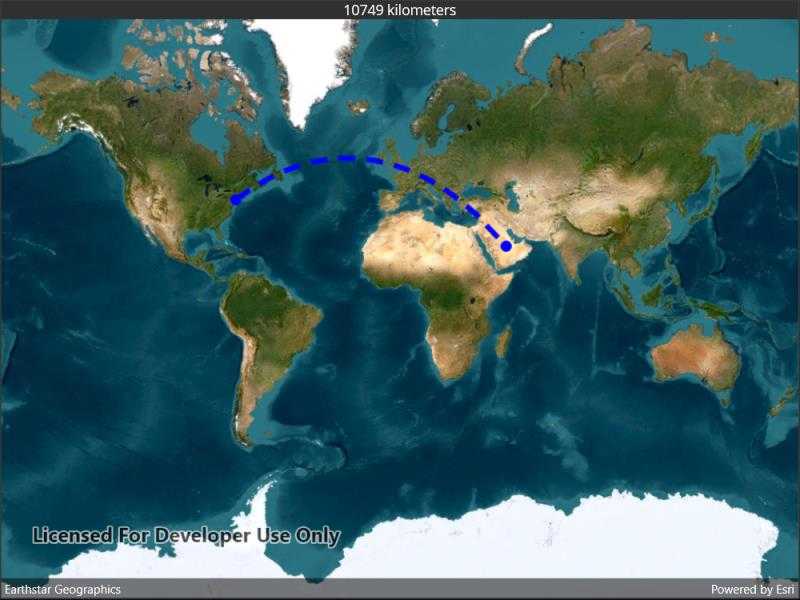Calculate a geodesic path between two points and measure its distance.

Use case
A geodesic distance provides an accurate, real-world distance between two points. Visualizing flight paths between cities is a common example of a geodesic operation since the flight path between two airports takes into account the curvature of the earth, rather than following the planar path between those points, which appears as a straight line on a projected map.
How to use the sample
Tap anywhere on the map. A line graphic will display the geodesic line between the two points. In addition, text that indicates the geodesic distance between the two points will be updated. Tap elsewhere and a new line will be created.
How it works
- A
Pointis created in New York City and displayed as aGraphic. - When a tap occurs on the
MapView, a newPointis obtained from the mouse click. ThisPointis added as aGraphic. - A
Polylineis created with the twoPointobjects. GeometryEngine.DensifyGeodeticis called from thePolylineobject, and the returnedGeometryis stored aspathGeometry.GeometryEngine.LengthGeodeticis called frompathGeometry, and the returned number is displayed on the screen.
Relevant API
- GeometryEngine.DensifyGeodetic
- GeometryEngine.LengthGeodetic
About the data
The Imagery basemap provides the global context for the displayed geodesic line.
Tags
densify, distance, geodesic, geodetic
Sample Code
// Copyright 2022 Esri.
//
// Licensed under the Apache License, Version 2.0 (the "License"); you may not use this file except in compliance with the License.
// You may obtain a copy of the License at: http://www.apache.org/licenses/LICENSE-2.0
//
// Unless required by applicable law or agreed to in writing, software distributed under the License is distributed on an
// "AS IS" BASIS, WITHOUT WARRANTIES OR CONDITIONS OF ANY KIND, either express or implied. See the License for the specific
// language governing permissions and limitations under the License.
using Esri.ArcGISRuntime.Geometry;
using Esri.ArcGISRuntime.Mapping;
using Esri.ArcGISRuntime.Symbology;
using Esri.ArcGISRuntime.UI;
using Colors = System.Drawing.Color;
using PointCollection = Esri.ArcGISRuntime.Geometry.PointCollection;
namespace ArcGIS.Samples.GeodesicOperations
{
[ArcGIS.Samples.Shared.Attributes.Sample(
name: "Geodesic operations",
category: "Geometry",
description: "Calculate a geodesic path between two points and measure its distance.",
instructions: "Tap anywhere on the map. A line graphic will display the geodesic line between the two points. In addition, text that indicates the geodesic distance between the two points will be updated. Tap elsewhere and a new line will be created.",
tags: new[] { "densify", "distance", "geodesic", "geodetic" })]
public partial class GeodesicOperations : ContentPage
{
// Hold references to the graphics.
private Graphic _startLocationGraphic;
private Graphic _endLocationGraphic;
private Graphic _pathGraphic;
public GeodesicOperations()
{
InitializeComponent();
// Setup the control references and execute initialization.
Initialize();
}
private void Initialize()
{
MyMapView.Map = new Map(BasemapStyle.ArcGISImageryStandard);
// Create the graphics overlay and add it to the map view.
GraphicsOverlay graphicsOverlay = new GraphicsOverlay();
MyMapView.GraphicsOverlays.Add(graphicsOverlay);
// Add a graphic at JFK to serve as the origin.
MapPoint start = new MapPoint(-73.7781, 40.6413, SpatialReferences.Wgs84);
SimpleMarkerSymbol startMarker = new SimpleMarkerSymbol(SimpleMarkerSymbolStyle.Circle, Colors.Blue, 10);
_startLocationGraphic = new Graphic(start, startMarker);
// Create the graphic for the destination.
_endLocationGraphic = new Graphic
{
Symbol = startMarker
};
// Create the graphic for the path.
_pathGraphic = new Graphic
{
Symbol = new SimpleLineSymbol(SimpleLineSymbolStyle.Dash, Colors.Blue, 5)
};
// Add the graphics to the overlay.
graphicsOverlay.Graphics.Add(_startLocationGraphic);
graphicsOverlay.Graphics.Add(_endLocationGraphic);
graphicsOverlay.Graphics.Add(_pathGraphic);
// Update end location when the user taps.
MyMapView.GeoViewTapped += MyMapViewOnGeoViewTapped;
}
private void MyMapViewOnGeoViewTapped(object sender, Esri.ArcGISRuntime.Maui.GeoViewInputEventArgs geoViewInputEventArgs)
{
// Get the tapped point, projected to WGS84.
MapPoint destination = (MapPoint)geoViewInputEventArgs.Location.Project(SpatialReferences.Wgs84);
// Update the destination graphic.
_endLocationGraphic.Geometry = destination;
// Get the points that define the route polyline.
PointCollection polylinePoints = new PointCollection(SpatialReferences.Wgs84)
{
(MapPoint) _startLocationGraphic.Geometry,
destination
};
// Create the polyline for the two points.
Polyline routeLine = new Polyline(polylinePoints);
// Densify the polyline to show the geodesic curve.
Geometry pathGeometry = routeLine.DensifyGeodetic(1, LinearUnits.Kilometers, GeodeticCurveType.Geodesic);
// Apply the curved line to the path graphic.
_pathGraphic.Geometry = pathGeometry;
// Calculate and show the distance.
double distance = pathGeometry.LengthGeodetic(LinearUnits.Kilometers, GeodeticCurveType.Geodesic);
ResultsLabel.Text = $"{(int)distance} kilometers";
}
}
}